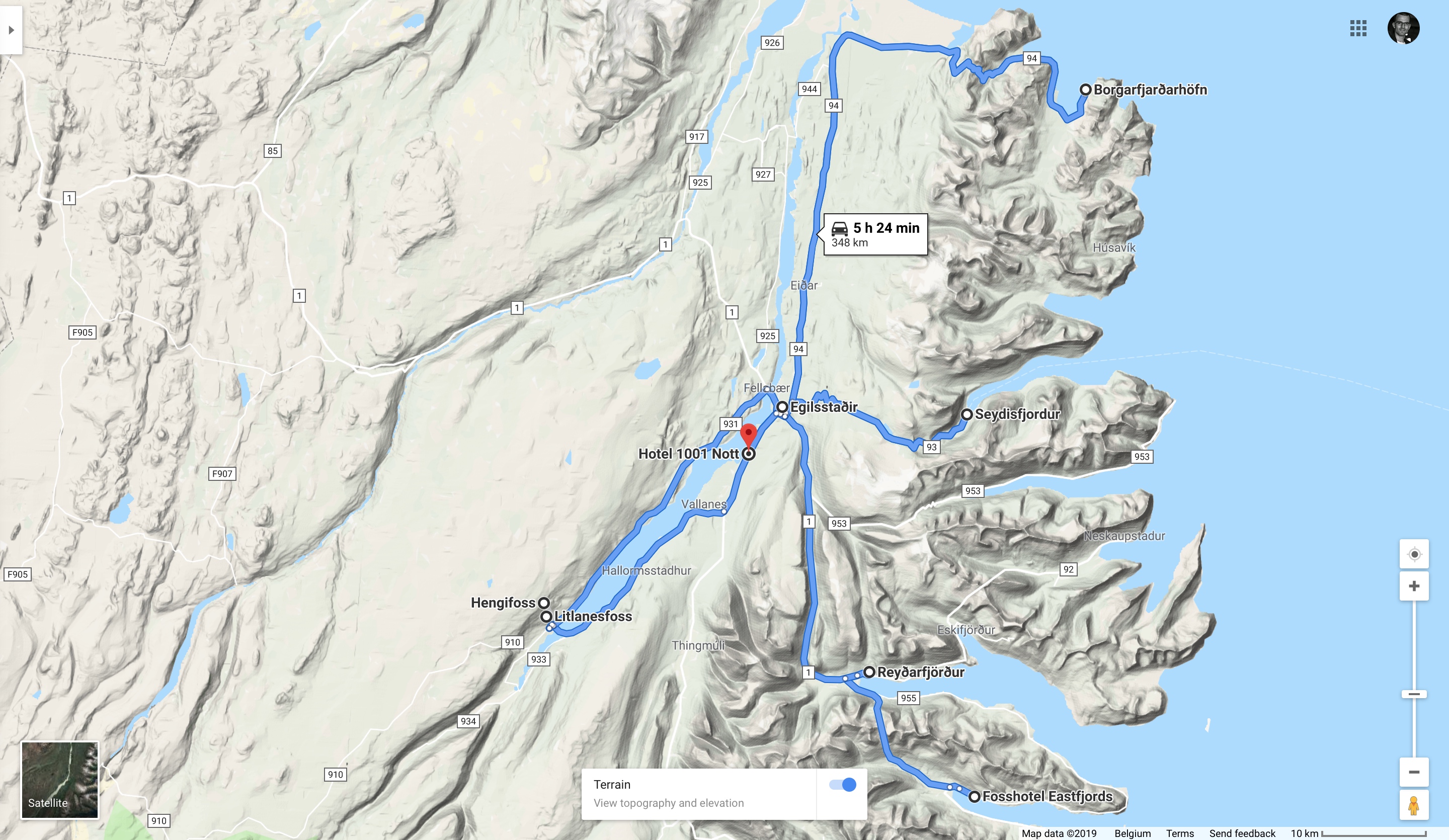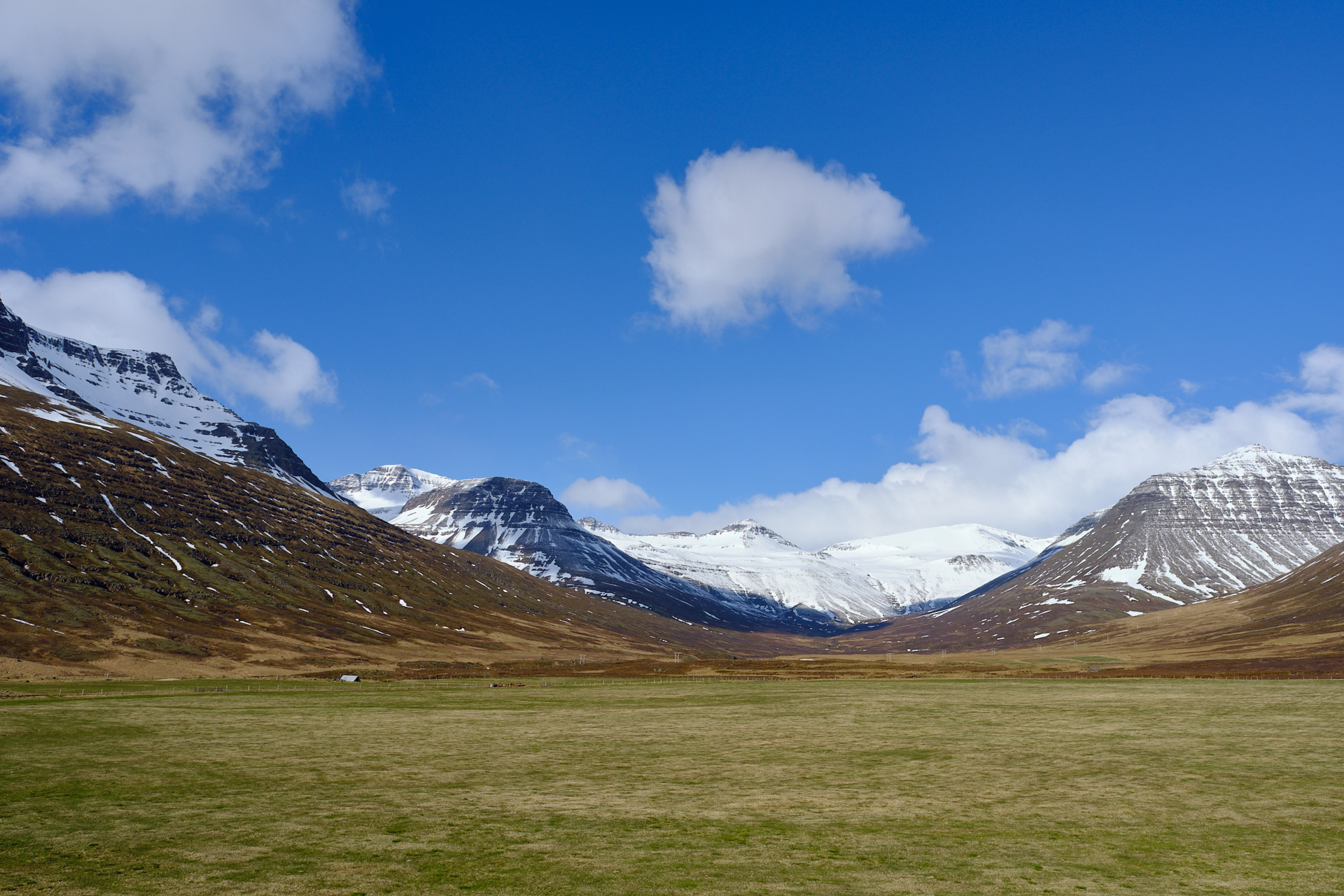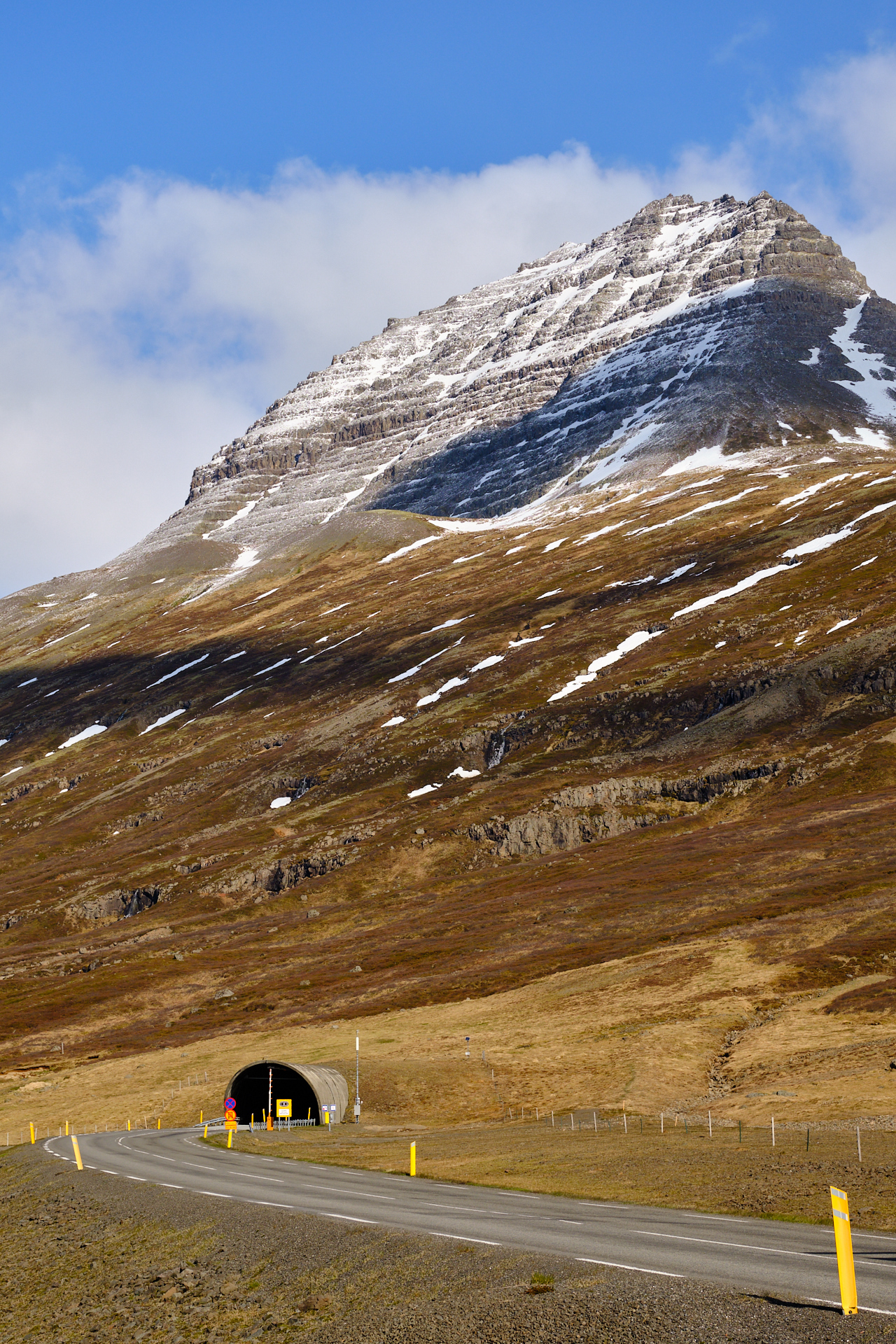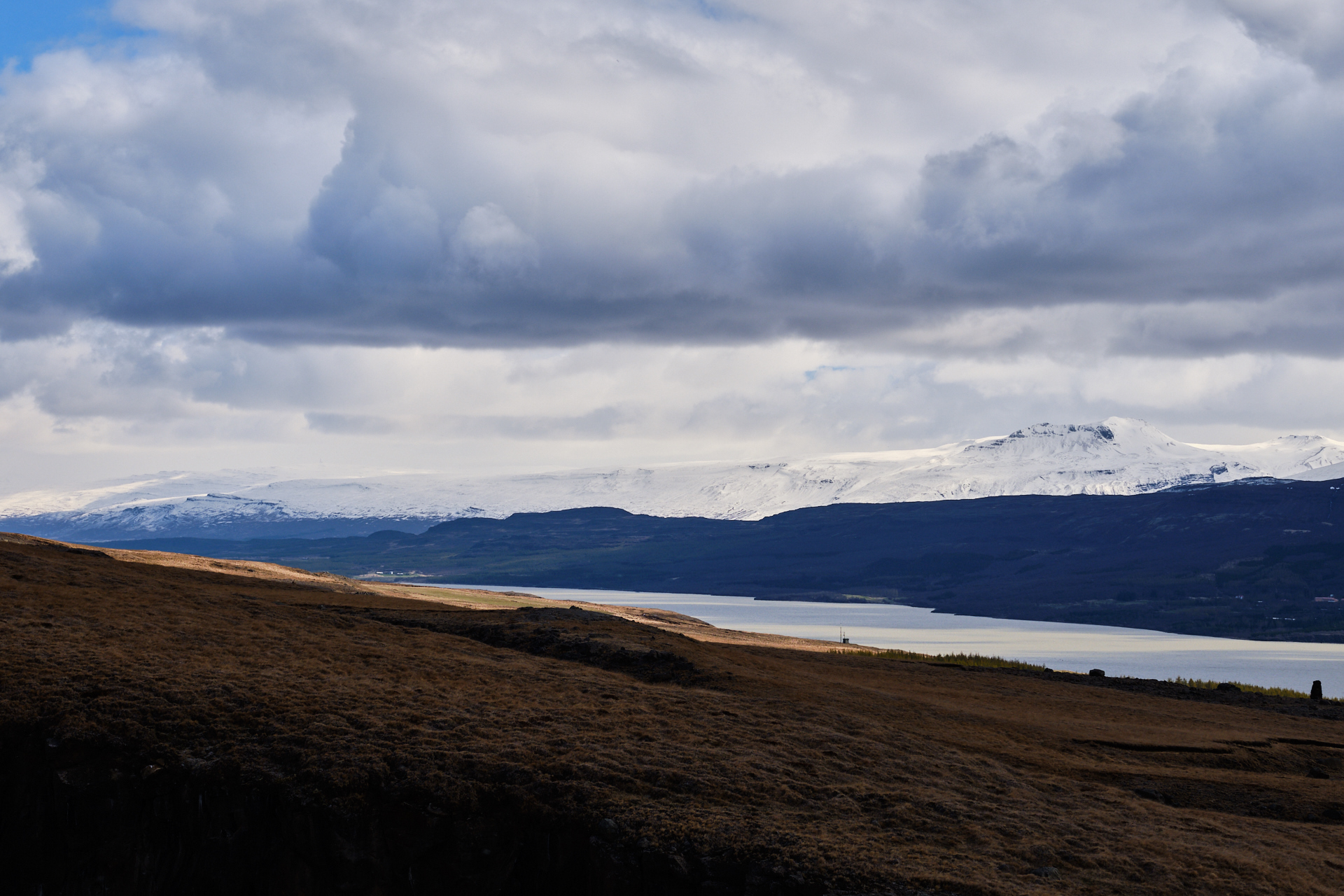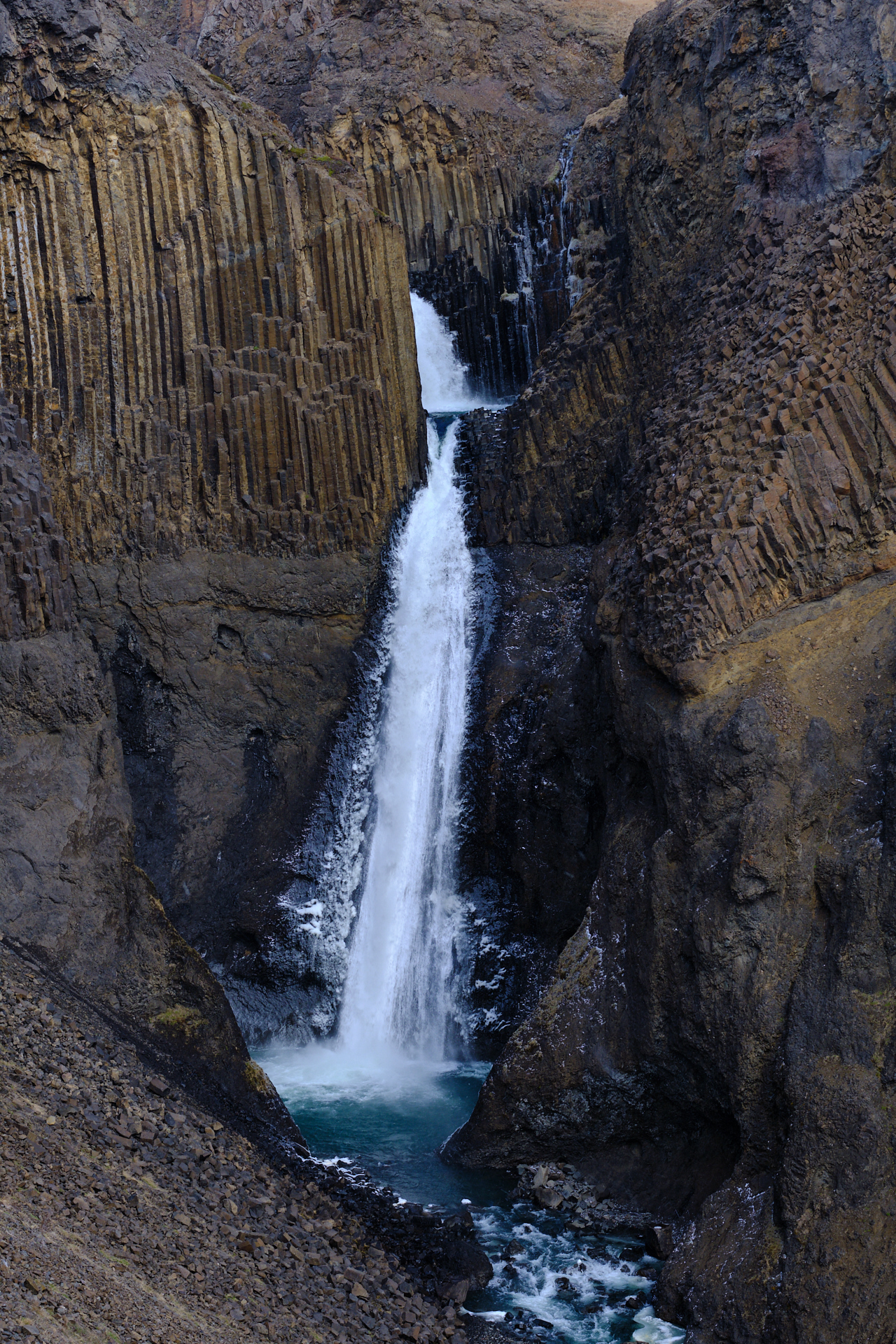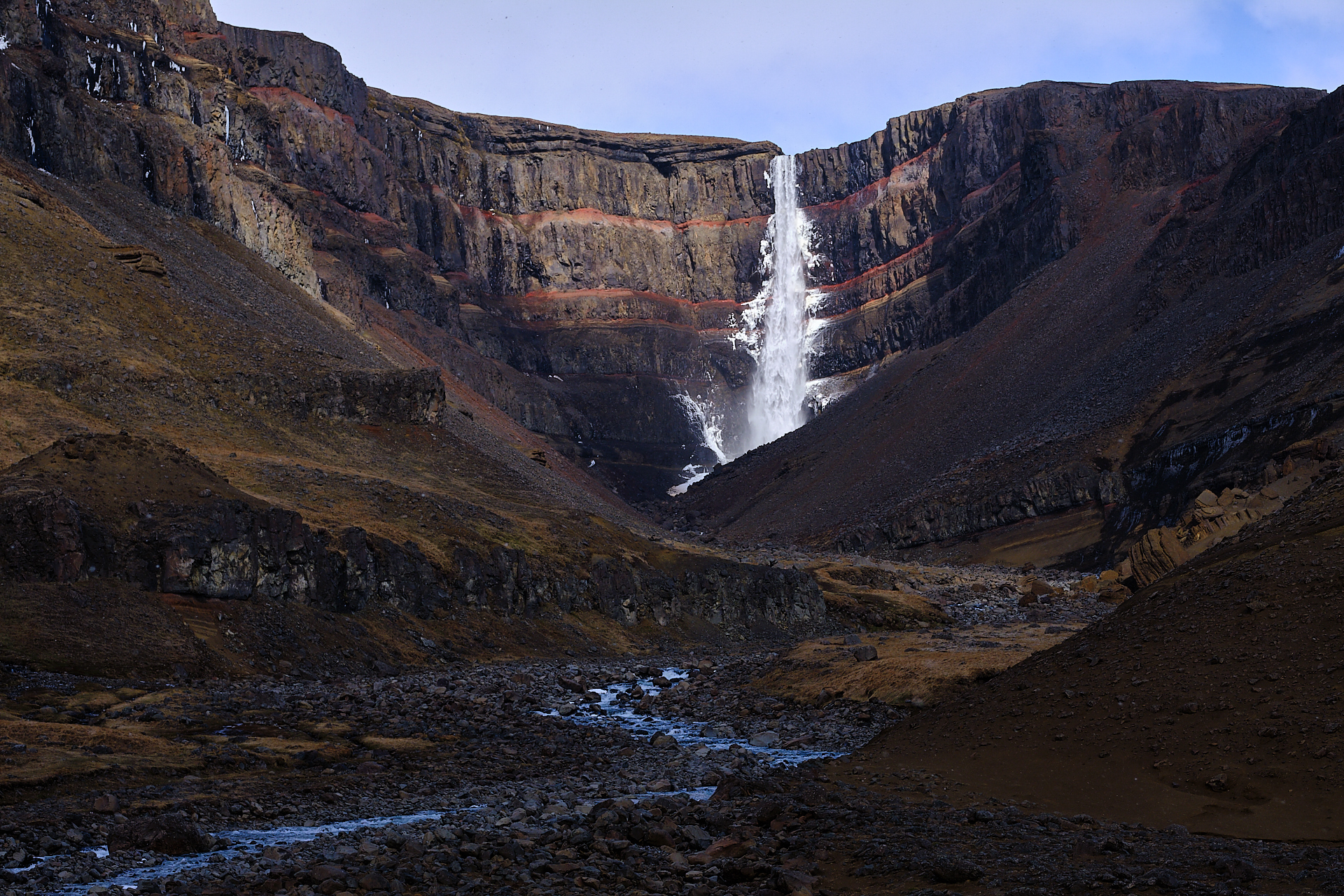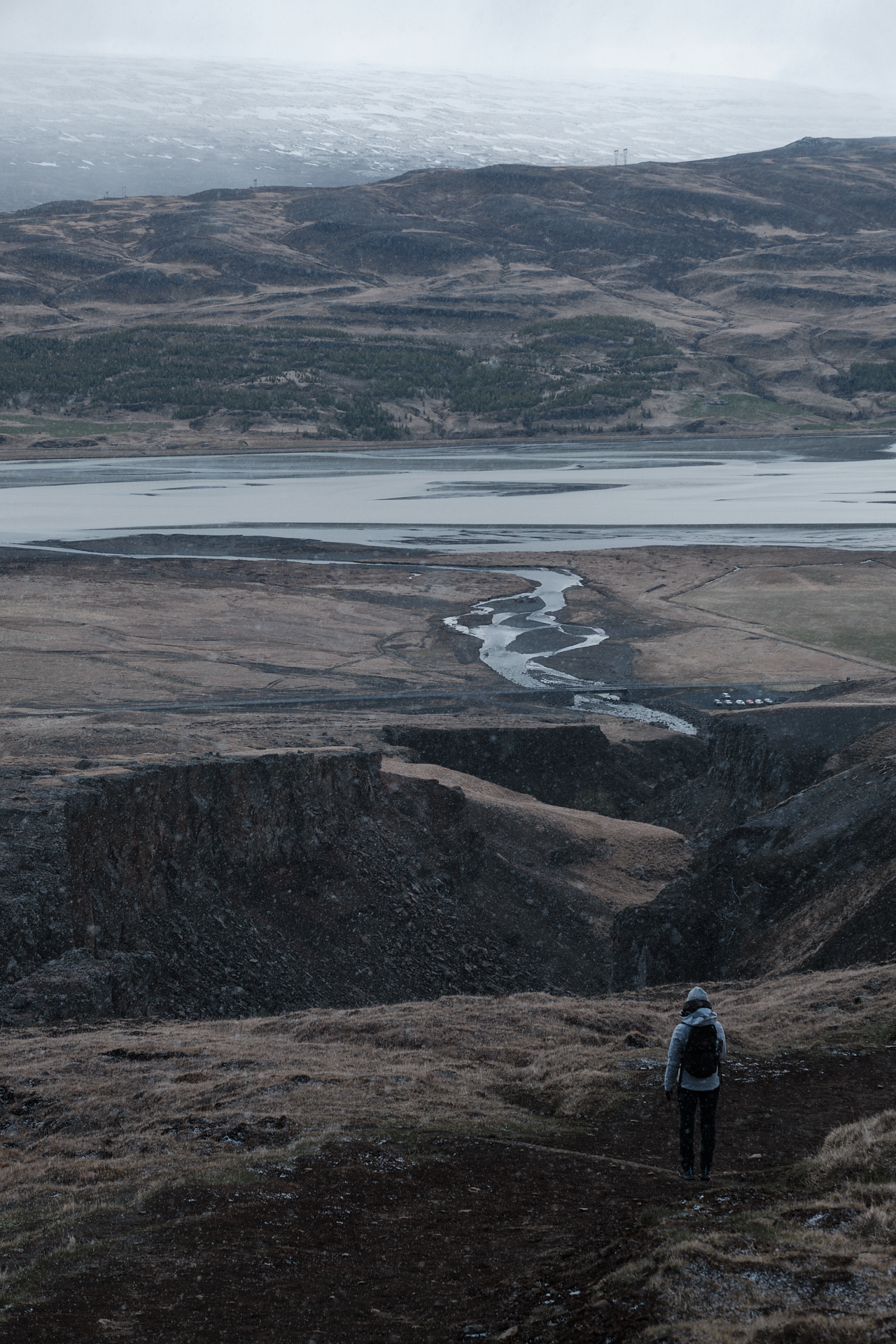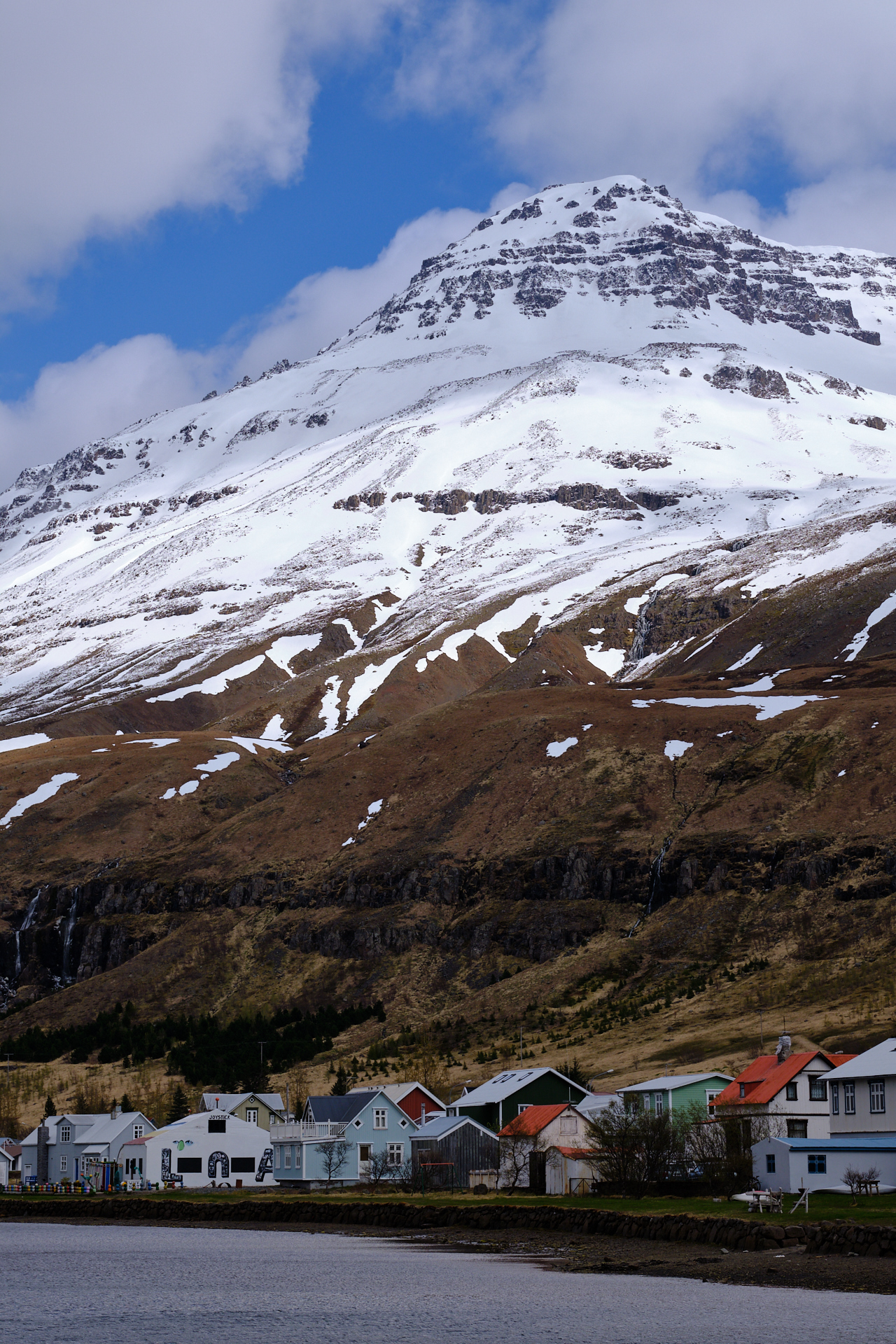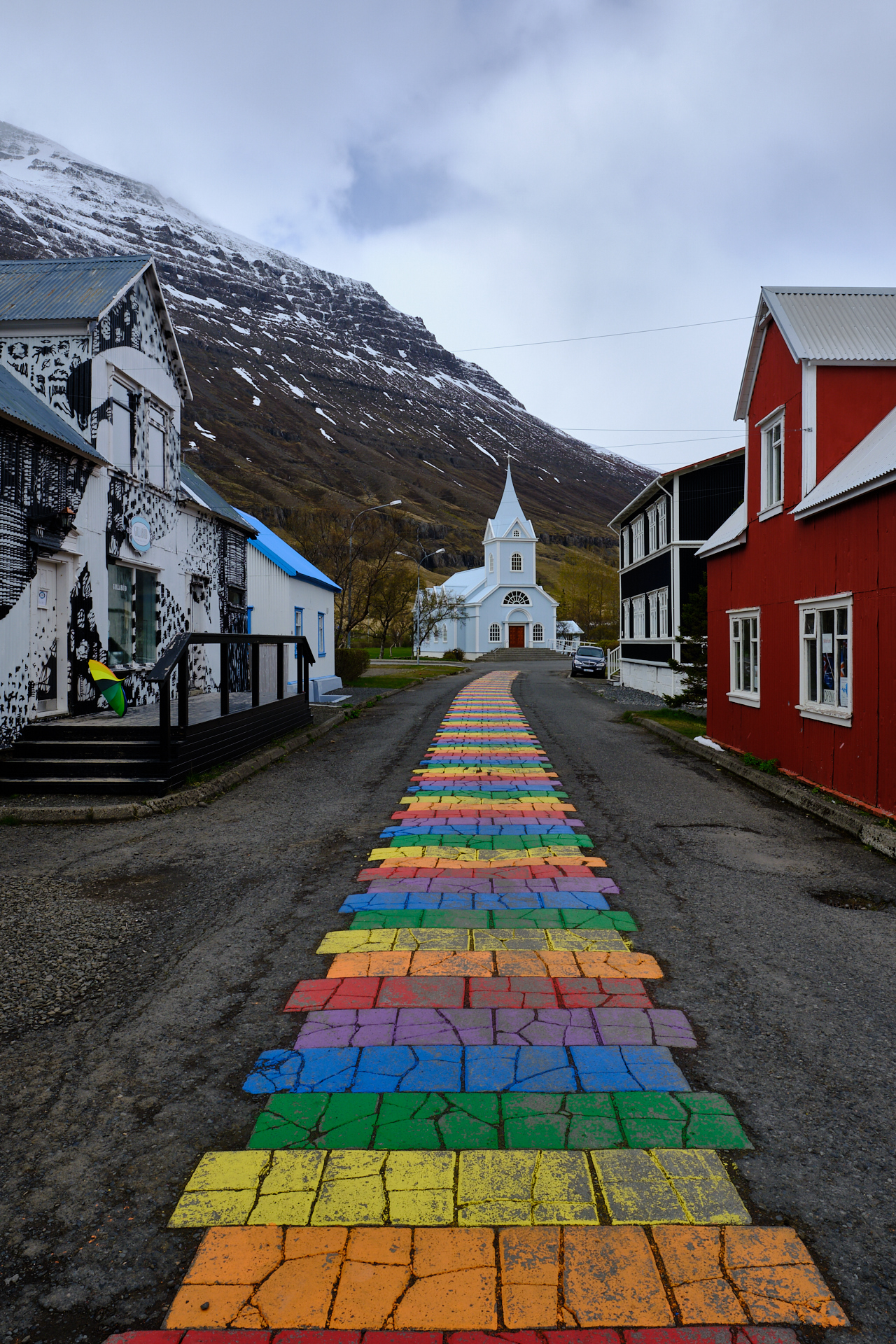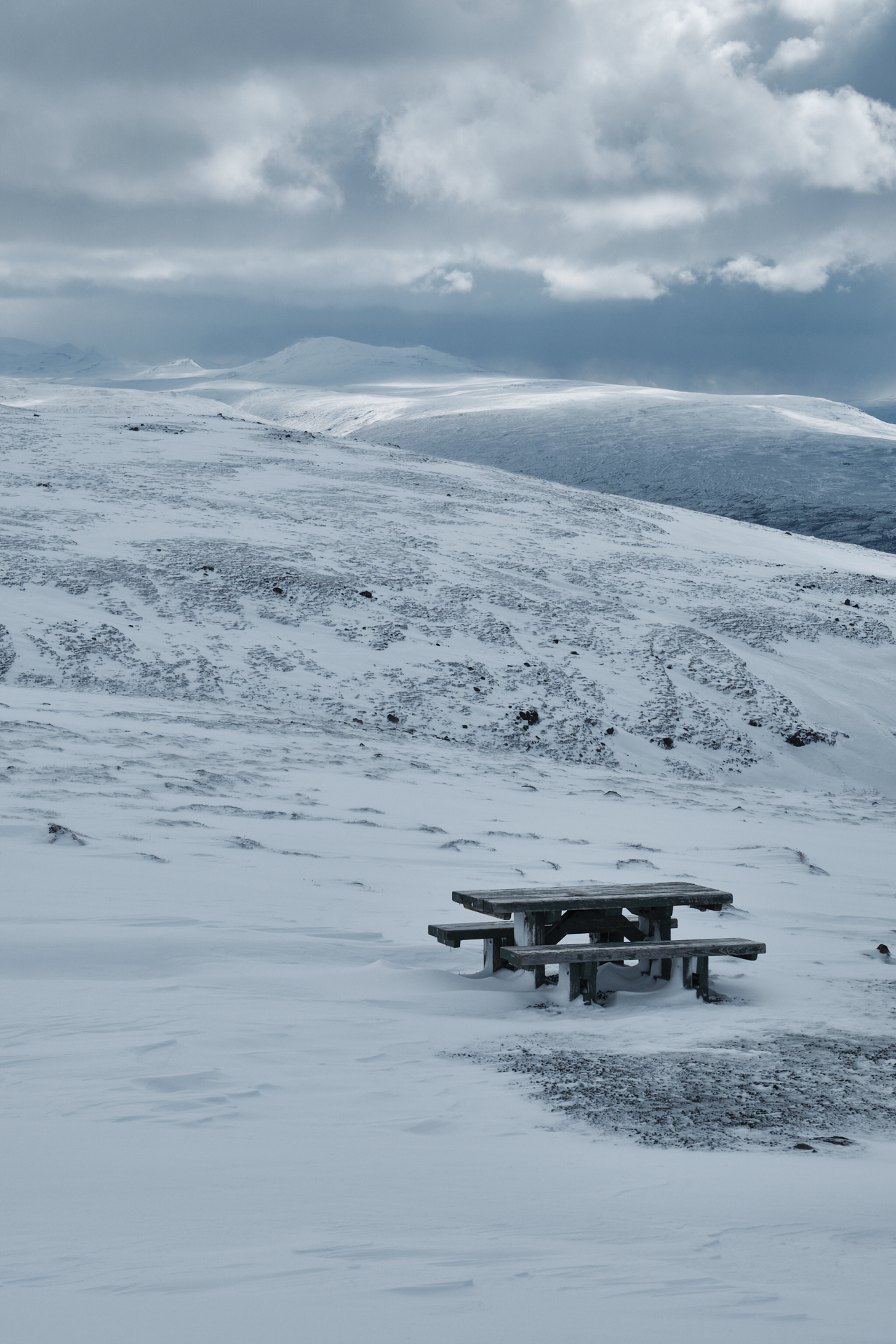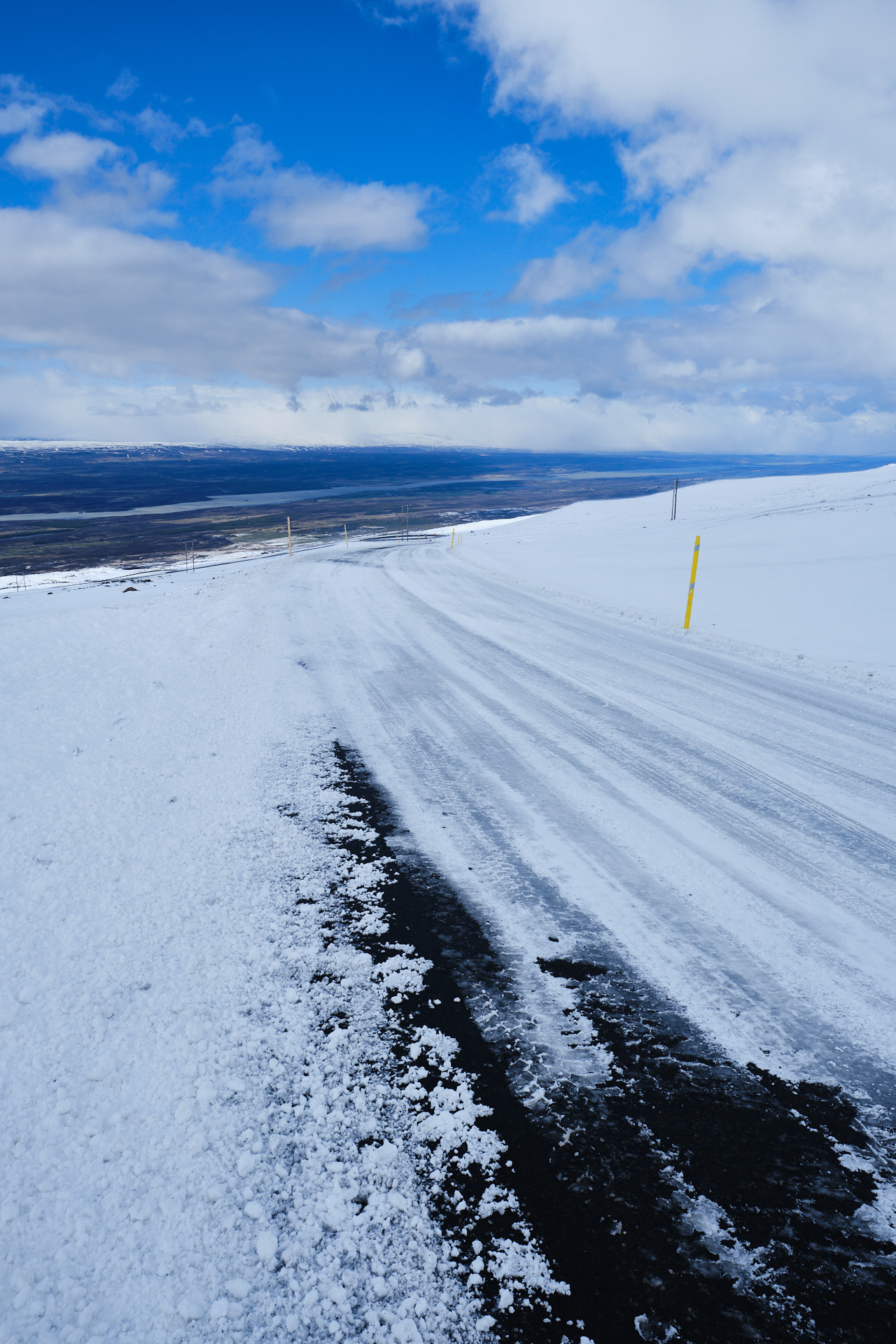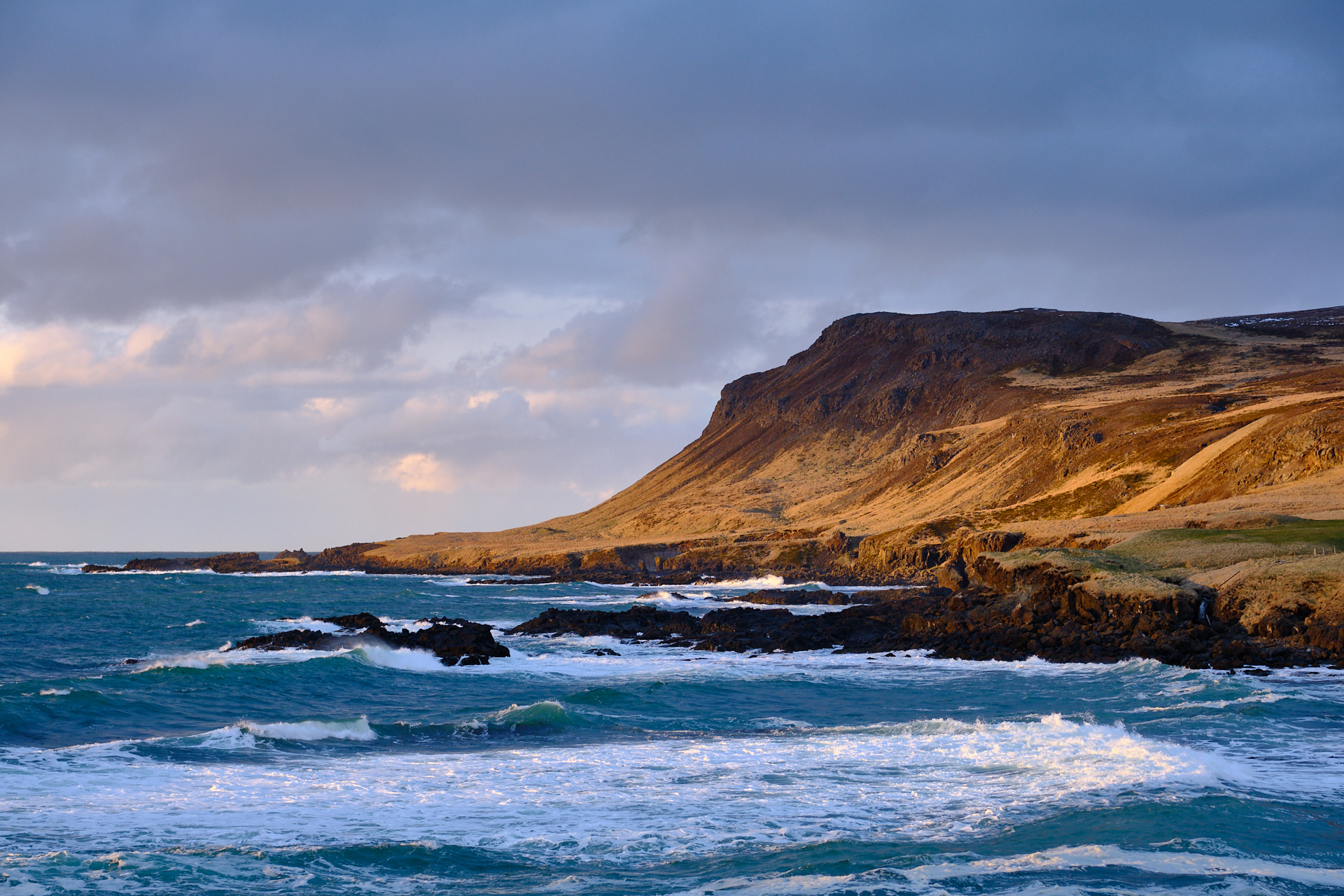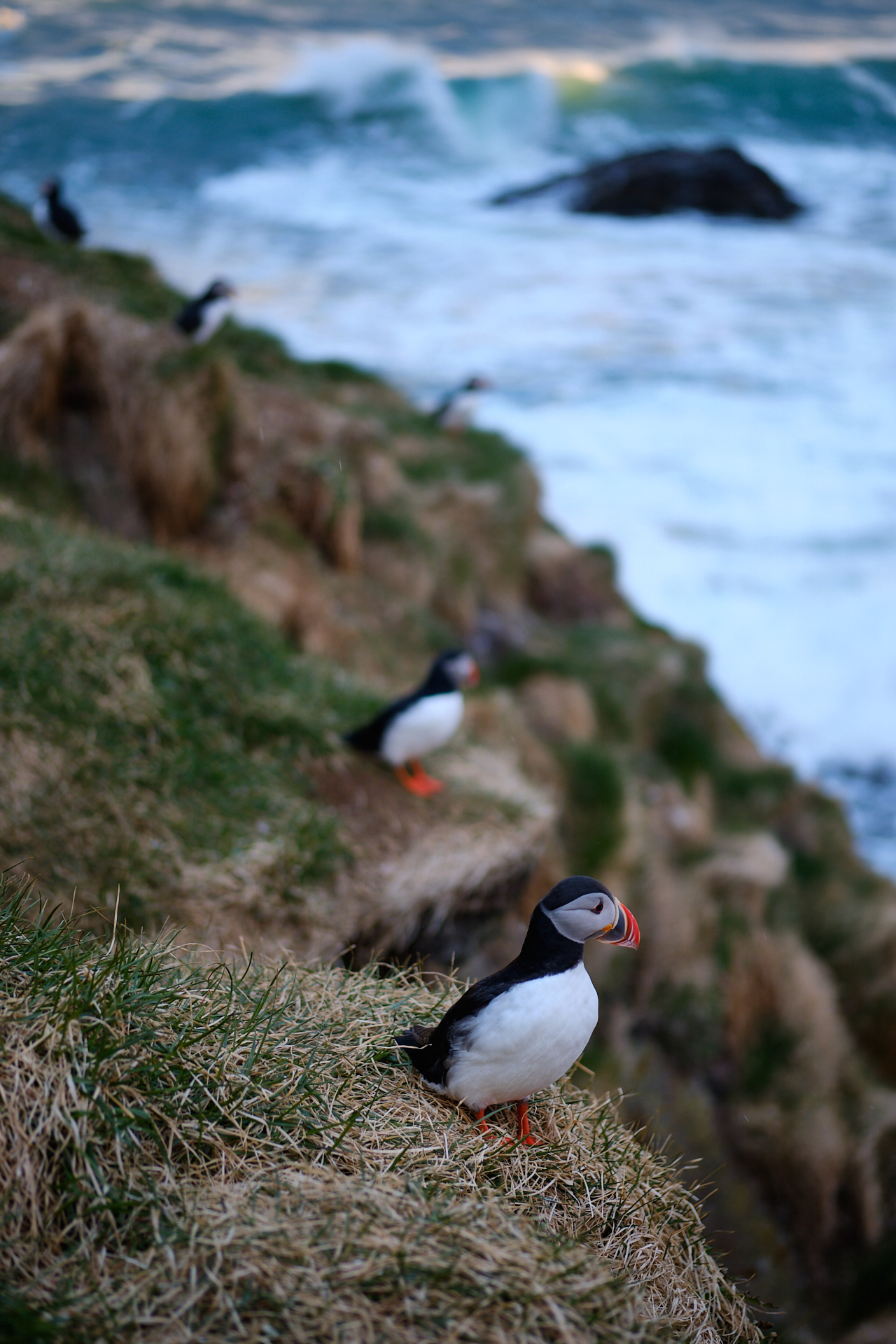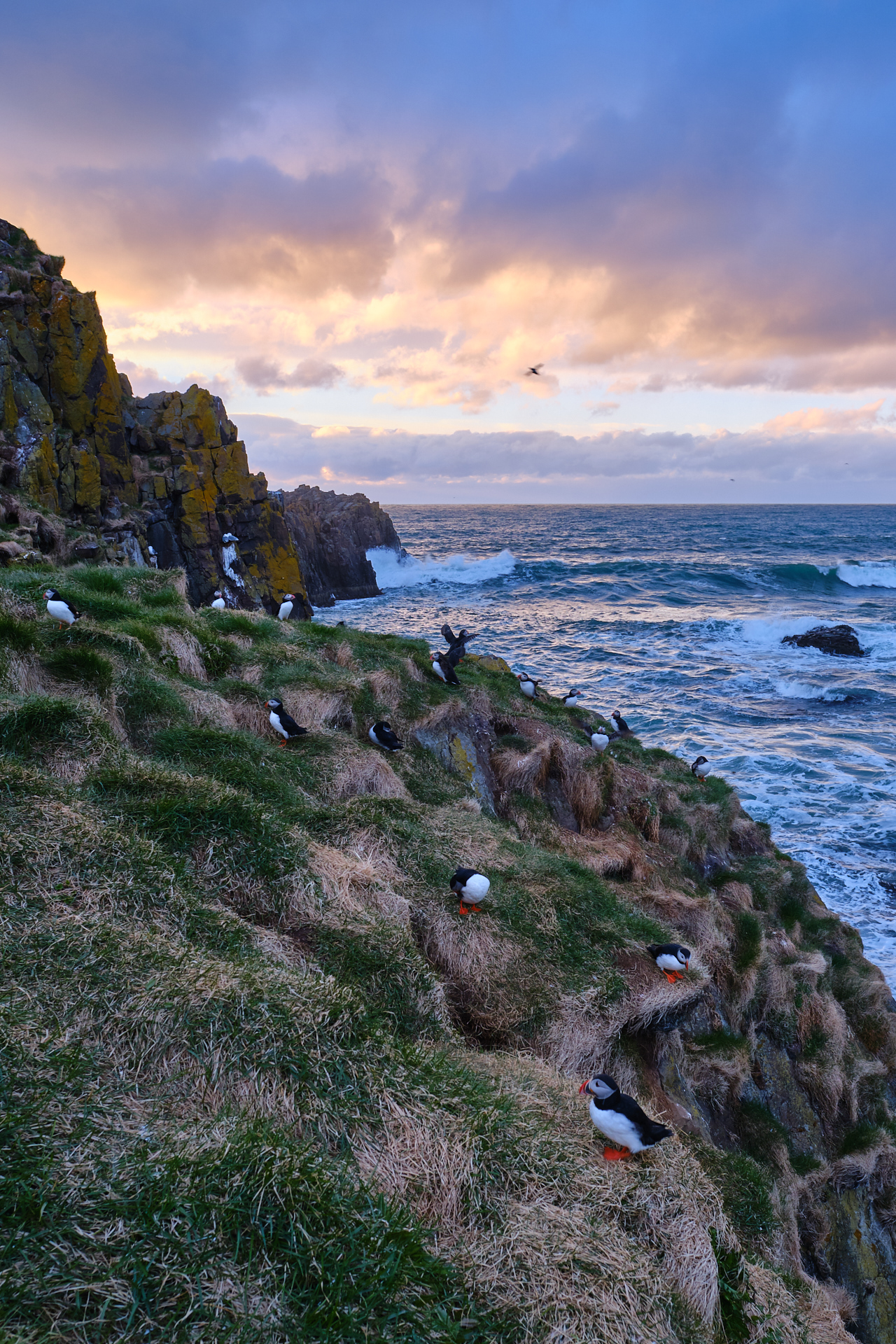Given that this was going to be one of our longest days (especially with the possibility of moving something from the next day to this evening, bot no spoilers), we had to get up very early. I was already taking pictures on the sunny (but barely above freezing) deck of the hotel at 8:30.
We had no breakfast booked here, so we just drove to the next village to get something from the bakery. (We were happy to see that after resetting it the previous evening, the tire pressure warning was not showing up on the dashboard anymore, and the tires were perfectly fine.)
Hungry for not only a pastry, but pictures of snow topped mountains and blue skies, I stopped along the road at least twice even before reaching the tunnel that takes the ring road from Fáskrúðsfjörður towards Reyðarfjörður, under one of the towering ridges of the Eastjords.
The only reason why we did not have to get up even earlier is that on a Saturday, the bakery (Sesam brauðhús) only opens at 9. We arrived not much later than that, so we still had to pick our orders from the loaded racks that were just being rolled out from the kitchen area. I cannot recommend this place enough, they had huge pastries, and everything we tasted was delicious. (While we were eating a snow shower passed outside). After breakfast we drove further North, climbing up a long, straight valley flanked by steep slopes, covered by a thin blanket of fresh snow. The road was most likely cleaned during the night (or the morning), but everything else around us was white, and the outside temperature displayed on our dashboard was just below zero.
The snow melted in the sunshine as we got lower again, heading towards, and into the largest village (city?) of the region, Egilsstaðir. We drove through the city during the day several times, and during one of our passages we stopped at the Bonus to recharge our cookie and snack reserves, but I don’t remember when exactly :) Anyway, here we turned Southwest on road 95, soon (after passing a few reindeers – this time crossing the road at a safe distance from us) followed by route 931, that bends around the lake of Lagarfljót. Along the South coast of the lake is one of the only regions in Iceland with an actual forest. We originally planned to stop for a short walk at the camping of Atlavik, but driving through the relatively lush landscape was satisfying enough, so we kept going further. Not much longer though, because a few minutes later we arrived to the parking of the first main attraction of the day.
From the parking a well marked and maintained trail climbs to the Litlanesfoss and Hengifoss waterfalls, that are wedged in a narrow and steep canyon, cutting into the Northwestern flanks of the valley. This was a really nice hike, with magnificent views into and along the valley below us, and to the snow topped mountains on the opposite side. What made it even better was the numerous, dense snow showers that kept coming and going every five minutes, constantly changing the view, the lights, and the colours around us. Perfect conditions for a photographer!
The Litlanesfoss is framed by beautiful, tall basalt columns, while the Hengifoss falls from the top of a wider rock face that consists of multiple horizontal layers of red, orange, and brown bedrock. At this time of the year the trail was only open until just 250 meters past the top of the Litlanesfoss, but from there there was already a very nice view to the second waterfall, so we did not mind turning back.
The walk down was even prettier (since we did not have to turn around to enjoy the views anymore), but I have the feeling (from the pressure on my arm) that Clio had enough of the snow showers by then (admittedly it was freezing, and wind was blowing snow in our face, but to me it was so cool), so I tried to not stop every 10 meters for another picture.
By the time we arrived back to the parking it was almost noon. From here we had to drive back to Egilsstaðir, but now we took the road over the Northern side of the lake. There were no forests here, but the yellow grass was glowing in the warm (looking) sunshine. A long section of the road was gravel here, and just as we were about to forget the problems with the tire pressure from the previous day, the indicator lamp lit up again on the dashboard. Since there was still quite some driving (and possibly snow and gravel) on the menu, we decided it was best to have a better look at the issue, so we drove to the local tire shop. Here they checked the pressure in no time and concluded that there was nothing wrong, and we should not worry about the indicator, it would likely still come on when driving on gravel. Feeling a bit relieved, we could continue along the original plan, and drive to one of the small villages of the fjords. Given the weather conditions, we picked the asphalted road to Seydisfjordur, skipping the gravel pass towards Mjóifjörður. Still, even the surfaced road was not an easy drive, there was still quite some snow and ice around the top of the pass (just over 600 meters above sea level, in -4°C, with a windchill below -20°C). The drive down from the pass is occasionally very steep, but again the typical horizontal layering of the Eastfjords appears on both sides of the glacier carved valley, and we even pass another waterfall on our way.
Seydisfjordur is a quite and cozy fishing village, but even here there are a few restaurants catering for the tourists that make it this far. (We also had lunch here, just a burger and a salad, nothing special.) There is a small church, some colourful houses, and an Instagram-famous rainbow-painted street all within a 100 meters. And of course there are the snowy mountains towering over the village on both sides.
It was almost three on the afternoon when we left the fjord, taking the one and only road back out of the valley. This time I decided to fight the elements and get out of the car on the top of the pass for a few pictures, but the windchill was horrible, so I did not spend a long time outside. The view was really nice (albeit very difficult to capture), as you could see the snow shovers passing over the landscape in the distance, leaving a white trail behind them.
Next we drove to our hotel (Hotel 1001 Nott – the hotel of the 1001 nights) to check in and relax a bit. There was floor heating in our room, and a beautiful view to the lake, so we both found it just perfect. While Clio enjoyed a cup of hot coffee, I was planning the rest of the day by repeatedly checking the road conditions, the weather (current and the forecast), and the webcams online for the region of Borgarfjörður. Just beyond this village there is a small harbour where puffins nest (in large numbers), and I wanted to go there either on the evening, or the next morning. While the weather was looking better for the morning, I knew that there was a much better chance of us seeing puffins on the evening, because they usually leave their nests after sunrise and come back just before sunset, but sunrise was so early (already in May) that there was no way that we could catch them then. Also, there was no winter service planned for Sunday on the gravel pass of road 94, so had the conditions deteriorated during the coming night, there was no way we could have gotten there on the next morning… I was a bit concerned about the conditions on the gravel pass though, because the webcam showed that there was definitely some snow being blown across the road (even though it was just powder and the surface was well visible below), and the traffic those days was extremely low with around 100 vehicles per day, so no constant stream of cars to keep the road clean. Still, after some thinking and a short consultation with the personnel at the reception we decided to give it a go, with the option of turning back in case the conditions would not turn out to be safe.
As I wanted to be there between 20:00 and 21:00 (and not much later so we could still come back before it gets “completely dark”), we still had plenty of time, so we packed up all our warm clothes (I am pretty sure I had an extra layer of long underpants), then drove to Egilsstaðir for dinner first. I was really excited by the possibility of seeing puffins in the wild for the first time in my life, and I was also afraid at the same time that we might not make it there because of the same weather that made the landscape so photogenic during the rest of the day. It took me quite some effort to not finish my pizza (at the Salt Café & Bistro) in two seconds, but there was really no point in leaving too early.
When we finally left the weather looked quite nice – while it was cold, the sky was mostly clear, with the low sun already turning orange, and there were only a few snow showers visible in the distance. We drove North on route 94 – asphalted in the first ten kilometres, but then turning gravel for the next twenty. The surface was still good, and the road mostly straight, so we could easily drive 60 km/h. To our left we had constant views to the Northern extension of the Lagarfljót (difficult to decide if it is a lake here or just a very wide outflow), with occasional snow shower curtains blocking the low-hanging sun behind it, while to the right we could see the snow covered mountain range standing between us and our destination. We did not really see anybody else around, there were only a few farms/guest houses along the road, and a small self-service booth (snacks and drinks from a vending machine). A few kilometres from the sea the gravel section ended and soon after the road turned sharply to the right, directly towards the mountains. I am really sad that I could not stop here somehow to take a picture, because the scenery in front of us was magnificent: the road was running straight at the mountains, cutting through the grassy marshlands that were glowing from the orange sunlight, in great contrast with the dark brown mountains, the snowy triangular peaks, and the deep purple sky above. Even though I don’t have a photograph, I will never forget that view.
Then the gravel pass started. The road got pretty steep and quite narrow very quickly, so I was driving very carefully. Maybe after only 50 meters of climbing there was already snow around us, and the higher we went the more of it. Near the top of the pass – at around 400 metres above the sea level – powder snow was being blown across the road, and the wind was building small snow dunes across the surface, which was slightly worrying, but we kept driving (but without a 4×4 we would not have done so). The descent went easier than the climb, not only because gravity was on our side, but mainly because the visibility of the road was better. From the bottom of the descent there was still a long stretch of quite bad gravel to be done (scattered with large holes), but based on the encountered road works this section might get a layer of asphalt in the not so distant future. Then finally as the road turned into the wide valley of Borgarfjörður Eystri, and we were back on smooth, hard surface. The small port of the puffins (Borgarfjarðarhöfn) was another five kilometres further beyond the village. We arrived to the relatively new parking area overlooking the small harbour around just a bit after eight. The harbour itself connects the mainland with a tiny island (or a larger rock), and that is where the puffins nest. There is a short but steep path (with stairs) that leads up to a couple of view points, and even a small house with a row of windows for photographers to hide with their large tele objectives (from not only the puffins but the elements too). Even without puffins, the panorama from this spot was great.
But luckily, there were puffins too! At first only a few, and they kept their distance, but as the evening progressed, more and more of them flew back from the sea, and since the space was limited, they had to land closer and closer to us to get to their nests. I was extremely happy to finally see puffins in the wild, and at the end it was not at all difficult to take some nice pictures of them either (even without a huge lens). I think the closest ones were not further than 3-5 meters from us. In the meantime light snow started to fall again, and it was getting late (while we were still one hour from sunset, the sun itself was already only 4 degrees above the horizon to the Northwest), so a few minutes after nine we decided that it was time to leave.
The drive back through the pass was a bit more difficult compared to two hours earlier, as there were a few deeper snow-dunes across the road, but we always had at least two wheels on gravel, so at the end it was not too bad. The rest of the remaining drive was easy, and we arrived back to our hotel around 22:15-22:30, just after sunset. Clio immediately fell asleep, but I only followed around midnight, as I was still too pumped from all the amazing experiences of the day, and I also wanted to put some picture online first. It was really nice, sitting in front of our floor to ceiling windows, in the quiet, looking at the clear sky above the lake, as the post-sunset colours ran from yellow to indigo above the horizon. This was definitely my favourite day in Iceland.
